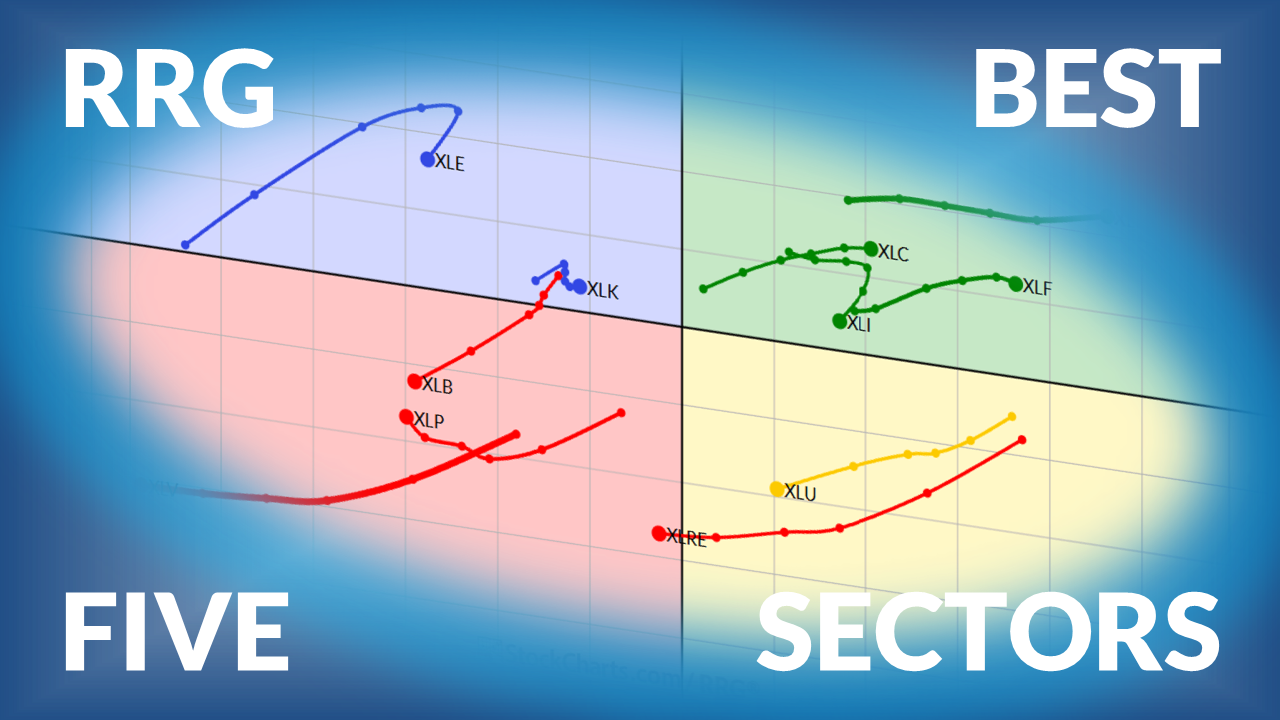CONSUMER DISCRETIONARY AND TECHNOLOGY SECTORS TAKE A DIVERGENCE -- UTILITIES LEAD EQUAL-WEIGHT SECTORS -- FALLING FLAG OR NEAR TERM TOP FOR XLY? -- TECHNOLOGY SPDR HOLDS GAP TO AFFIRM RESISTANCE -- NAKED MACD TRENDS LOWER FOR COMMODITY INDEX FUND
CONSUMER DISCRETIONARY AND TECHNOLOGY SECTORS TAKE A DIVERGENCE... Link for today's video. Investors shifted away from the consumer discretionary and technology sectors over the last two weeks. Even though this is a relatively short-term development, it comes with the market short-term overbought and ripe for a correction. Relative weakness in these two key sectors could foreshadow a corrective period in the near future. PerfChart 1 shows the sector PerfChart with the nine sector SPDRs and the S&P 500 ETF (SPY). Notice that seven of the nine sectors are up, as is SPY. The Consumer Discretionary SPDR (XLY) and the Technology SPDR (XLK) are the only two sectors showing negative returns the last 10 days. These two are clearly underperforming the broader market.

(click to view a live version of this chart)
Chart 1
The overall market is up because there are six sectors outperforming SPY. The Healthcare SPDR (XLV) is the best performing sector with a 1.86% gain the last two weeks. Also notice that the Finance SPDR (XLF), Industrials SPDR (XLI), Basic Materials SPDR (XLB), Energy SPDR (XLE) and even the Utilities SPDR (XLU) are outperforming SPY. The Consumer Staples SPDR (XLP) is up over the period as well, but underperforming SPY because it shows a smaller gain.
UTILITIES LEAD EQUAL-WEIGHT SECTORS ... PerfChart 2 shows nine sector ETFs as well, but these are the equal-weight ETFs. In addition, I am using the S&P 500 Equal-Weight ETF (RSP) instead of SPY for the benchmark. In contrast to the equal-weight ETFs, the sector SPDRs are dominated by their large-cap constituents with the top ten stocks accounting for most of the price movement. These equal-weight ETFs level the playing field to give us an idea of the sector as a whole. In other words, these ETFs reflect performance for the average stock within the sector. This chart shows similar results because the Equal-weight Consumer Discretionary ETF (RCD) and Equal-weight Technology ETF (RYT) are the only two showing losses over the last two weeks. The Equal-weight Utilities ETF (RYU) is the top performer with a 2% gain in 10 days.

(click to view a live version of this chart)
Chart 2
FALLING FLAG OR NEAR TERM TOP FOR XLY?... Even though the Consumer Discretionary SPDR (XLY) remains in a clear uptrend over the last six months, the ETF stalled over the last two weeks and a near term top could be taking shape. Chart 3 shows XLY moving from 50 to 60 since February. This is a 20% advance in less than six months. Not bad. The wedge breakout in early July provided the most recent signal and the stock is up 10% since late June. By most accounts, XLY is medium-term and short-term overbought. Overbought, however, is probably the most over-used term in an uptrend. The two week consolidation looks like a falling flag and a break above this week's high would signal a continuation higher. A break below the lower trend line would negate the flag and argue for a retracement of the prior advance. Broken resistance turns first support in the 57 area. The indicator window shows the price relative peaking on July 12th and moving lower the last two weeks. Notice that two weeks of relative weakness in May foreshadow the prior correction (red line). Chart 4 shows the Equal-weight Consumer discretionary ETF (RCD) with similar characteristics.

(click to view a live version of this chart)
Chart 3

(click to view a live version of this chart)
Chart 4
TECHNOLOGY SPDR HOLDS GAP TO AFFIRM RESISTANCE... Chart 5 shows the Technology SPDR (XLK) hitting resistance near the May high and falling last week with a gap. This gap has now held for five days as the ETF consolidates in the 31.50-31.75 area. Notice that XLK also broke the short-term trend line extending up from the June low. The trend line break and gap are short-term negative as long as they hold. With a slight rise, the consolidation looks like a rising flag and a break below flag support would signal a continuation of last week's decline. The indicator window shows XLK relative to the S&P 500 ETF. With the price relative hitting a new low, large-cap techs are clearly lagging the market and underperforming.

(click to view a live version of this chart)
Chart 5

(click to view a live version of this chart)
Chart 6
Chart 6 shows the Equal-weight Technology ETF (RYT) for comparison. Notice that the equal-weight version did break its May high and remains above the May high. Broken resistance in the 65.5-66 area turns into first support. The indicator window shows the price relative comparing RYT to the S&P 500 Equal-Weight ETF (RSP). Relative performance has turned flat since early June. A break below the June-July low would suggest relative weakness and this would be a negative for the technology sector.
NAKED MACD TRENDS LOWER FOR COMMODITY INDEX FUND... Even though Spot Light Crude ($WTIC) is trading near its 2012 high, other commodities remain in clear downtrends and have yet to join crude. Chart 7 shows the Commodity Index Fund (DBC) with a large falling channel over the last three years. This is pretty amazing because crude and related products account for over 50% of the ETF. More recently, DBC has been trending down since peaking in September 2012. The ETF established clear resistance with the May-June highs (red line). A break above this level is needed to reverse the ten month slide. The indicator window shows naked MACD with a trend line defining its downtrend. This is simply MACD set at (12,26,1) to hide the histogram and signal line. A break above this trend line would provide the first positive sign for momentum. Chart 8 shows the Base Metals ETF (DBB) within a downtrend as well. First resistance is set at 18.

(click to view a live version of this chart)
Chart 7

(click to view a live version of this chart)
Chart 8
NIKKEI 225 TURNS AT KEY RETRACEMENT... After a big surge from mid May to mid November, the Nikkei 225 ($NIKK) is looking vulnerable to a correction in the coming weeks or months. Chart 9 shows the Nikkei peaking in mid May, bouncing from mid June to mid July and rolling over this week. Notice that the index reversed near the 61.80% retracement. In addition, it is possible that an Elliott ABC correction is unfolding. This would imply a wave C decline towards the 11500 area. A lot depends on the Yen because yen weakness fueled the advance from mid November to mid May. The indicator window shows the Yen Index ($XJY) in a downtrend overall, but stalling with a triangle the last 2-3 months. A bounce off the 100 area would be negative for the Nikkei, while a break below the July low would be positive for Japanese stocks.









